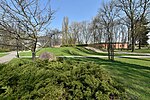Citadel Rail Bridge
Bridges in Warsaw

The Citadel Rail Bridge (Most przy Cytadeli) was a bridge in Warsaw, crossing the Vistula River. It opened in November, 1875, and was expanded with a second part in 1908. It was blown up for the final time in 1944 and was later replaced with the Gdański Bridge.
Excerpt from the Wikipedia article Citadel Rail Bridge (License: CC BY-SA 3.0, Authors, Images).Citadel Rail Bridge
Wybrzeże Helskie, Warsaw Praga-Północ (Warsaw)
Geographical coordinates (GPS) Address Nearby Places Show on map
Geographical coordinates (GPS)
| Latitude | Longitude |
|---|---|
| N 52.260555555556 ° | E 21.009166666667 ° |
Address
Most Gdański
Wybrzeże Helskie
00-221 Warsaw, Praga-Północ (Warsaw)
Masovian Voivodeship, Poland
Open on Google Maps











